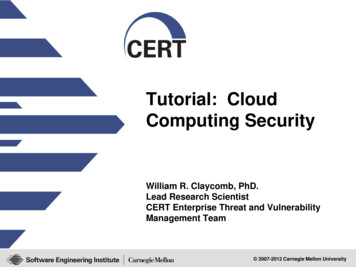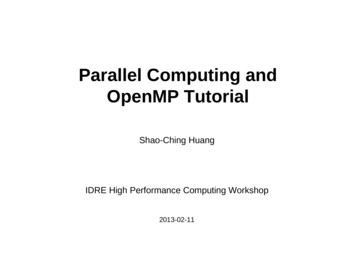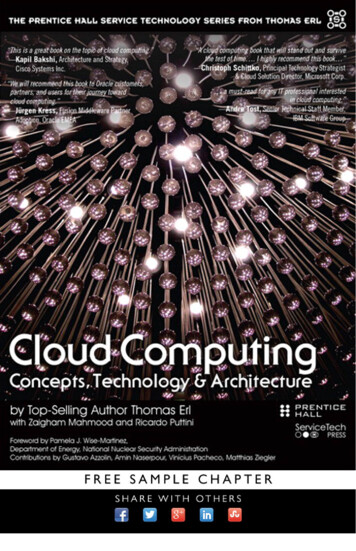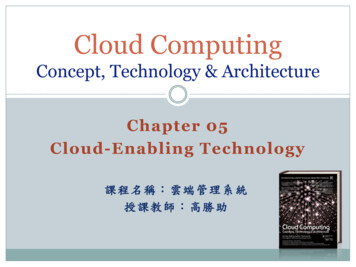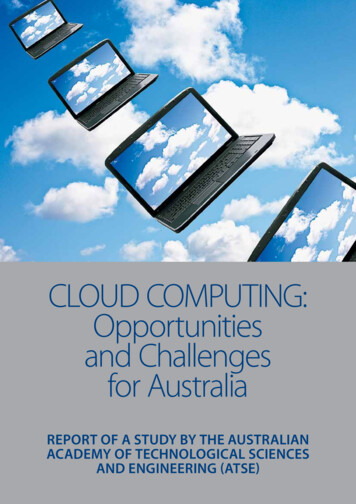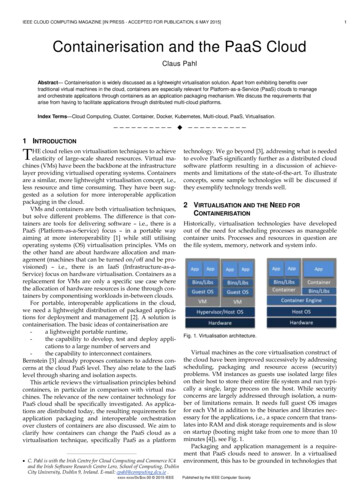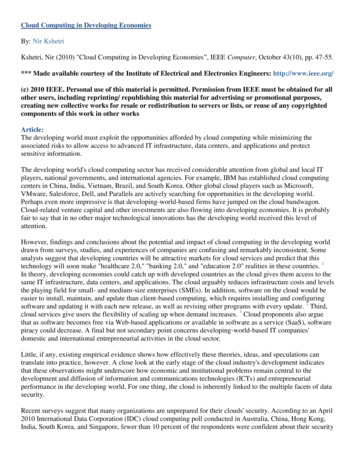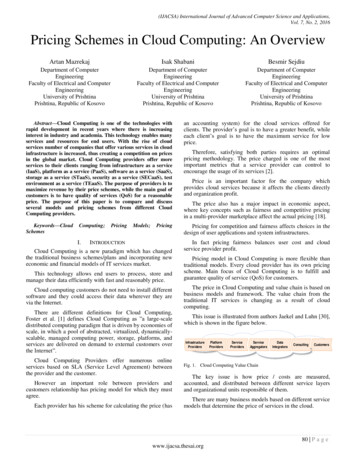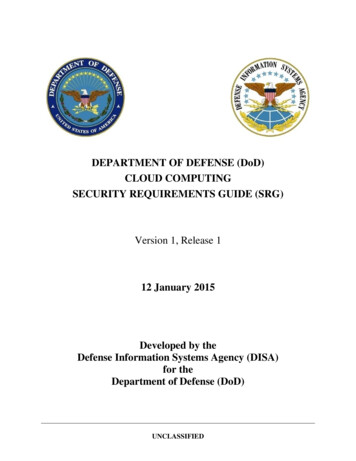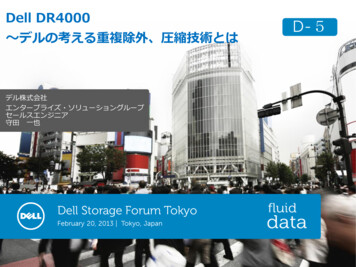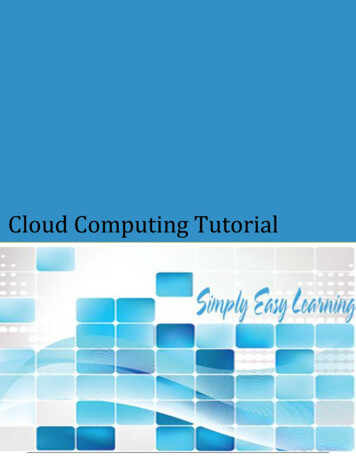
Transcription
Cloud Computing Tutorial
CLOUD COMPUTINGTUTORIALSimply Easy Learning by tutorialspoint.comtutorialspoint.comi
ABOUT THE TUTORIALCloud Computing TutorialCloud Computing provides us a means by which we can access the applications as utilities, over theinternet. It allows us to create, configure, and customize the business applications online.This tutorial will take you through a step-by-step approach while learning Cloud Computing concepts.AudienceThis reference has been prepared for the beginners to help them to understand the basic-to-advancedconcepts related to Cloud Computing. This tutorial will give you enough understanding on CloudComputing concepts from where you can take yourself to a higher level of expertise.PrerequisitesBefore proceeding with this tutorial, you should have basic knowledge of Computers, Internet, Databaseand Networking concepts. Such basic knowledge will help you in understanding the Cloud Computingconcepts and move fast on the learning track.Copyright & Disclaimer Notice Allthe content and graphics on this tutorial are the property of tutorialspoint.com. Any content fromtutorialspoint.com or this tutorial may not be redistributed or reproduced in any way, shape, or formwithout the written permission of tutorialspoint.com. Failure to do so is a violation of copyright laws.This tutorial may contain inaccuracies or errors and tutorialspoint provides no guarantee regarding theaccuracy of the site or its contents including this tutorial. If you discover that the tutorialspoint.com siteor this tutorial content contains some errors, please contact us at webmaster@tutorialspoint.comTUTORIALS POINTSimply Easy Learning
Table of ContentCloud Computing Tutorial. 2Audience . 2Prerequisites . 2Copyright & Disclaimer Notice . 2Cloud Computing - Overview . 9What is Cloud? . 9What is Cloud Computing? . 9Basic Concepts. 10DEPLOYMENT MODELS . 10History . 12Benefits . 12Risks . 13SECURITY & PRIVACY . 13LOCK-IN . 13ISOLATION FAILURE . 13MANAGEMENT INTERFACE COMPROMISE . 14INSECURE OR INCOMPLETE DATA DELETION . 14Characteristics . 14ON DEMAND SELF-SERVICE . 14BROAD NETWORK ACCESS . 14RESOURCE POOLING . 15RAPID ELASTICITY . 15MEASURED SERVICE . 15Cloud Computing - Planning . 16Strategy Planning Phase . 17CLOUD COMPUTING VALUE PROPOSITION . 17CLOUD COMPUTING STRATEGY PLANNING . 18Cloud Computing Tactics Planning Phase . 18BUSINESS ARCHITECTURE DEVELOPMENT . 18IT ARCHITECTURE DEVELOPMENT . 18REQUIREMENTS ON QUALITY OF SERVICE DEVELOPMENT . 18TRANSFORMATION PLAN DEVELOPMENT . 18Cloud Computing Deployment Phase . 18CLOUD COMPUTING PROVIDER . 19MAINTENANCE AND TECHNICAL SERVICE . 19Cloud Computing-Technologies . 20Virtualization . 20TUTORIALS POINTSimply Easy Learning
Service-Oriented Architecture(SOA). 21Grid Computing . 22Utility Computing . 23Cloud Computing-Architecture . 24FRONT END . 25BACK END . 25Cloud Computing Infrastructure. 26HYPERVISOR . 26MANAGEMENT SOFTWARE . 26DEPLOYMENT SOFTWARE . 26NETWORK . 26SERVER . 27STORAGE . 27Infrastructural Constraints . 27TRANSPARENCY . 27SCALABILITY . 27INTELLIGENT MONITORING . 27SECURITY . 28Public Cloud Model . 29Benefits . 30COST EFFECTIVE . 30RELIABILITY. 30FLEXIBILITY . 30LOCATION INDEPENDENCE . 30UTILITY STYLE COSTING . 30HIGH SCALABILITY . 30Disadvantages . 31LOW SECURITY. 31LESS CUSTOMIZABLE . 31Private Cloud Model . 32HIGHER SECURITY AND PRIVACY . 33MORE CONTROL. 33COST AND ENERGY EFFICIENCY . 33Disadvantages . 33RESTRICTED AREA . 33INFLEXIBLE PRICING. 33LIMITED SCALABILITY . 33ADDITIONAL SKILLS . 34Hybrid Cloud Model. 35TUTORIALS POINTSimply Easy Learning
Benefits . 35SCALABILITY . 36FLEXIBILITY . 36COST EFFICIENCIES . 36SECURITY . 36Disadvantages . 36NETWORKING ISSUES . 36SECURITY COMPLIANCE . 36INFRASTRUCTURAL DEPENDENCY . 37Community Cloud Model . 38Benefits . 39COST EFFECTIVE . 39SECURITY . 39ISSUES . 39lnfrastructure-as-a-service. 40Benefits . 41FULL CONTROL OVER COMPUTING RESOURCES THROUGHADMINISTRATIVE ACCESS TO VMS . 41FLEXIBLE AND EFFICIENT RENTING OF COMPUTER HARDWARE . 42PORTABILITY, INTEROPERABILITY WITH LEGACY APPLICATIONS 42Issues . 42COMPATIBILITY WITH LEGACY SECURITY VULNERABILITIES . 42VIRTUAL MACHINE SPRAWL . 43ROBUSTNESS OF VM-LEVEL ISOLATION . 43DATA ERASE PRACTICES . 43Characteristics . 43Platform-as-a-Service . 44Benefits . 45LOWER ADMINISTRATIVE OVERHEAD . 46LOWER TOTAL COST OF OWNERSHIP . 46SCALABLE SOLUTIONS . 46MORE CURRENT SYSTEM SOFTWARE . 46Issues . 46LACK OF PORTABILITY BETWEEN PAAS CLOUDS . 47EVENT BASED PROCESSOR SCHEDULING . 47SECURITY ENGINEERING OF PAAS APPLICATIONS . 47Characteristics . 47PaaS Types . 48STAND-ALONE DEVELOPMENT ENVIRONMENTS . 48TUTORIALS POINTSimply Easy Learning
APPLICATION DELIVERY-ONLY ENVIRONMENTS . 48OPEN PLATFORM AS A SERVICE . 48ADD-ON DEVELOPMENT FACILITIES . 48Software-as-a-Service . 49Characteristics . 49Benefits . 50MODEST SOFTWARE TOOLS . 50EFFICIENT USE OF SOFTWARE LICENSES. 50CENTRALIZED MANAGEMENT & DATA . 50PLATFORM RESPONSIBILITIES MANAGED BY PROVIDERS . 50MULTITENANT SOLUTIONS . 50Issues . 51BROWSER BASED RISKS . 51NETWORK DEPENDENCE . 51LACK OF PORTABILITY BETWEEN SAAS CLOUDS . 51OPEN SAAS AND SOA . 51ldentity-as-a-Service . 53Identity .
The concept of Cloud Computing came into existence in 1950 with implementation of mainframe computers, accessible via thin/static clients. Since then, cloud computing has been evolved from static clients to dynamic ones from software to services. The following diagram explains the evolution of cloud computing: Benefits
